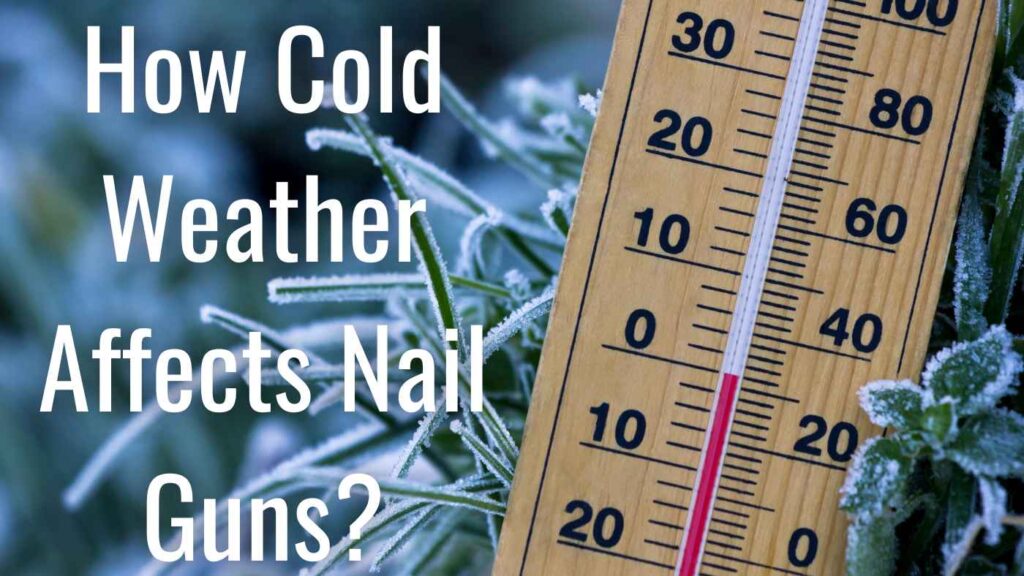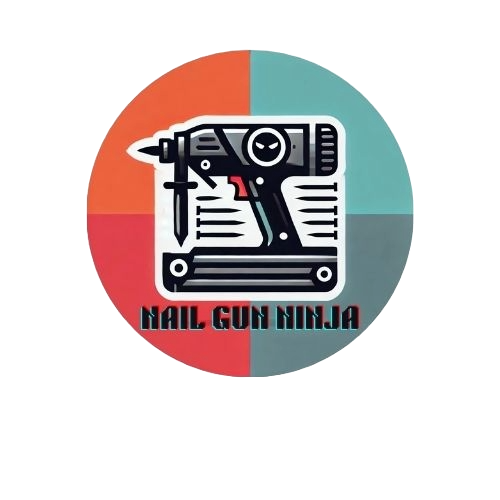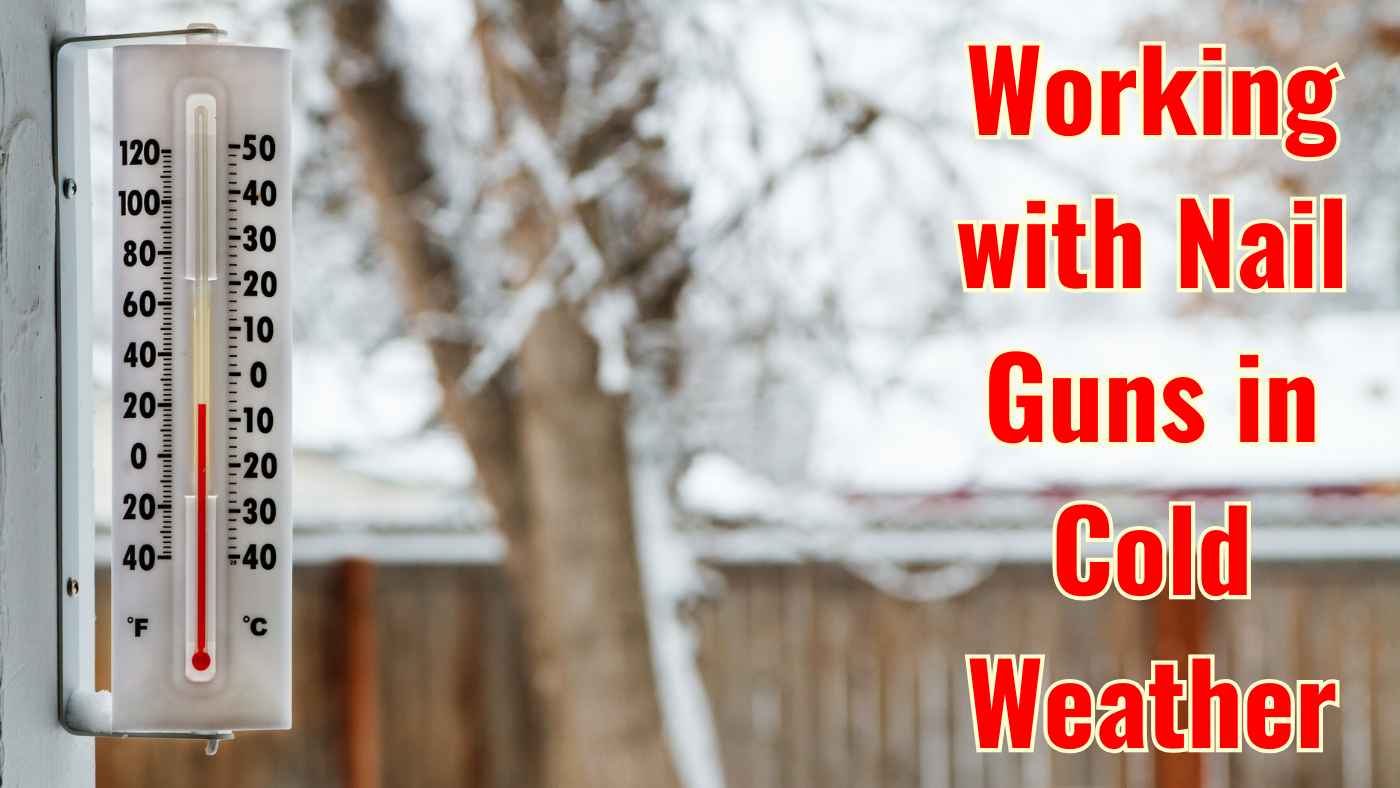Working with nail guns in cold weather comes with its own set of challenges.
The cold can lower air pressure in pneumatic nailers, slow down battery performance in cordless models, and make materials more likely to crack or split.
Plus, working in freezing temperatures can make it harder to grip tools and stay comfortable.
But don’t worry—by understanding how cold weather affects your nail gun and taking a few smart precautions, you can keep your projects running smoothly.
How Cold Weather Affects Nail Guns?

If you’ve ever had issues like misfires or slow performance in freezing temperatures, you’re not alone.
Here is what happens when it’s cold and how to fix it:
Air Pressure Drops in Pneumatic Nail Guns
When it’s cold, air compressors have trouble keeping up the right pressure.
This can cause pneumatic nail guns to misfire, drive nails too shallow, or not work at all.
Cold weather also thickens the oil in the compressor and makes it slower.
Fix It:
- Use oil designed for cold weather to keep the compressor working well.
- Keep the compressor in a warmer spot or cover it to keep it insulated.
- Increase the compressor pressure slightly to cover up the cold condition.
Cordless Nail Gun Batteries Drain Faster
Battery-powered nail guns don’t last as long in cold weather conditions.
The batteries lose power faster when it’s cold. So you will need to recharge more often.
Fix It:
- Store spare batteries in a warm place, like an insulated case or your pocket.
- Don’t leave batteries outside in the cold for too long.
- Charge your batteries in a warm space to help them last longer.
Hoses Become Stiff and Brittle
In cold weather, air hoses for pneumatic nail guns can get stiff and break more easily. It can cause power loss and air leaks.
Fix It:
- Use hoses made for cold weather to keep them flexible.
- Store hoses in a warm place when not in use.
- Check hoses regularly for cracks or leaks.
Increased Risk of Material Splitting
Cold weather also makes wood and other materials more brittle. It increases the risk of cracks or splits when nailing, especially with thin boards or hardwoods.
Fix It:
- Use smaller nails to put less pressure on the material.
- Set the nail gun to a shallower depth to avoid using too much force.
- Pre-drill holes in fragile wood to stop it from splitting.
Condensation and Moisture Buildup
When tools warm up after being in the cold, moisture can form inside them.
This can lead to rust and damage to the inside of pneumatic nail guns and compressors.
Fix It:
- Drain the air compressor tank regularly to remove moisture.
- Use lubricants that resist moisture in your pneumatic nail gun.
- Store your tools in a dry, climate controlled space when not in use.
User Comfort and Control Issues
Cold weather can make it harder for you to hold the tool while working. It increases the risk of accidents like misfires or dropping the tool.
Fix It:
- Wear hand gloves that still allow you to move your fingers.
- Take breaks in a warm place to keep your hands from stiffening up.
- Use hand warmers to keep your fingers flexible.
Top Cold Weather Nail Gun Accessories
When you are working with a nail gun in cold weather, having the right accessories can make all the difference.
It will make an impact on how your tools perform, how comfortable you feel, and how safe you are.
Here are some key accessories to help you tackle those chilly temperatures:
Cold Weather Air Compressor Oil
If you are using a pneumatic nail gun, switching to special cold weather air compressor oil can keep everything running smoothly.
Regular oil can thicken in the cold. This issue will cause airflow problems and misfires.
Heated Work Gloves
Cold hands can make it harder to grip your nail gun and control it.
Heated or insulated gloves give you warmth without making your fingers stiff. So, you can keep a steady grip and work safely.
Winter Grade Pneumatic Hoses
Normal air hoses can stiffen and crack in freezing weather, which can slow down your tool.
Winter grade hoses stay flexible, ensuring smooth airflow and preventing kinks that can mess with your nail gun.
Lithium-Ion Batteries
For cordless nail guns, lithium-ion batteries perform better in cold weather than older types.
Keep a spare battery warm in your pocket or an insulated case to help it last longer.
Portable Jobsite Heater
A jobsite heater can help warm up your workspace, making things easier for both you and your tools.
It prevents moisture buildup in your air lines and keeps your batteries running smoothly.
Anti-Fog Safety Glasses
Cold air can cause your safety glasses to fog up, which reduces visibility.
Anti-fog glasses keep your vision clear. So, you can see what you are doing and stay safe from debris.
Moisture Resistant Nail Gun Lubricant
Cold temperatures can cause condensation in air-powered tools.
A moisture resistant lubricant helps prevent rust and ensures your nail gun keeps firing properly.
Can I use Nail Guns During Snowfall?
It’s generally not recommended to use a nail gun during snowfall. Using a nail gun in snowfall isn’t ideal for a few reasons.
Here are the main reasons:
Moisture Damage
Snow can get into your nail gun and cause rust or internal malfunctions.
Safety Risks
Wet, slippery surfaces can make it dangerous to handle a nail gun and increase the risk of accidents.
Performance Issues for Pneumatic Nailers
Cold and snow can make the air in pneumatic nail guns condense, causing jams or reduced performance.
Performance Issues for Cordless Nailers
For battery-powered or gas nail guns, the cold can drain the battery or reduce gas efficiency.
Best Practices for Using Nail Guns in Cold Weather
Using a nail gun in cold weather can be challenging. But with a few simple steps, you can make sure your tools work well.
Here are some easy tips for using nail guns in the cold:
Warm Up Your Tools First
Cold weather can make tools work slower. Before you start, let your nail gun and air compressor warm up a little.
This will help them run better and avoid problems.
Use Cold Weather Accessories
Make sure you are using accessories made for the cold.
Winter-grade hoses, cold weather air compressor oil, and lithium-ion batteries can all help keep your nail gun working smoothly in freezing temperatures.
Keep Batteries and Tools Warm
If you are using a battery powered nail gun, keep extra batteries in a warm place, like your pocket or an insulated case.
For air powered tools, try to keep them in a warm area when not in use to avoid freezing and moisture.
Check for Moisture Regularly
Cold weather can cause condensation to build up inside your pneumatic tools, leading to rust.
To prevent this, drain your air compressor regularly to get rid of any moisture.
Also, use moisture-resistant lubricants to keep your nail gun working smoothly.
Don’t Overwork Your Nail Gun
Nail guns can get worn out faster in the cold. Give your tools regular breaks to cool down and avoid overloading them with too much work at once.
Stay Safe and Comfortable
Cold hands can make it harder to grip your nail gun and work safely.
Wear warm gloves that still let you move your fingers, and take breaks in a warm area to avoid hand stiffness.
Moreover, keep your tools dry and protected from the cold.
How to Adjust Your Technique for Cold Weather Projects
Here’s how to make your cold-weather work easier and safer:
Adjust Nail Depth
Cold weather can make wood more brittle. It is important to set your nail gun to the right depth.
Make sure the nails are driven just deep enough without pushing too hard, which can cause the material to crack.
Always test on a scrap piece of wood first to get it right.
Use Shorter, Lighter Strokes
In cold conditions, materials can be stiffer, making it harder for your nail gun to drive nails properly.
Try to use shorter and lighter strokes to prevent misfires and avoid damaging the material.
Take your time and make sure the nails go in the right way before moving on.
Keep the Nail Gun Moving
To avoid putting too much pressure on one spot, keep the nail gun moving smoothly. Otherwise, it will crack.
This will help you drive the nails evenly without causing damage to your wood or other materials.
Switch to Smaller Gauge Nails
Cold temperatures make materials like wood more likely to crack. So, it is a good idea to use smaller gauge nails.
These small nails are less likely to cause the material to split when you are working with hardwoods or thinner boards.
Handle Materials Gently
Cold wood is more fragile, so handle your materials with extra care.
Avoid dropping or mishandling the pieces, as they can crack more easily.
If possible, store the materials in a warmer place before using them to reduce fragility.
Take Frequent Breaks
Cold weather can make your hands and fingers stiff. Hence, it is important to take regular breaks.
Stretch and warm up to stay comfortable and keep your grip strong on the nail gun. This will help you maintain control and prevent mistakes.
Watch Your Grip
Cold hands can make it harder to grip your nail gun tightly. Hold it firmly, but not too tight.
Wear gloves that keep your hands warm but still allow you to move your fingers easily. This way, you will have better control and comfort.
Adjust Nail Gun Pressure Settings
In cold weather, the air pressure in your compressor can drop, which can make your pneumatic nail gun less powerful.
To make up for this, slightly increase the pressure to ensure the nails go in properly.
Test the pressure on a scrap piece of wood first to make sure it’s just right.
Prevent Moisture Buildup
Cold weather can cause moisture to build up inside your pneumatic nail gun, which can freeze and cause malfunctions.
To avoid this, regularly drain your air compressor to remove moisture.
Use lubricants that are resistant to moisture to keep your tools running smoothly.
The Impact of Temperature on Nailers Performance
Freezing Temps vs. Mild Cold
The colder it gets, the more likely your nail gun will run into problems.
Even just mild cold can drain your battery faster while freezing temperatures can cause parts inside the tool to freeze up.
Ideal Temperature Range
Most nail guns perform best when it is between 40°F and 100°F (4°C to 38°C). If it is colder or hotter than that, you might start seeing some issues with how the tool works.
Signs Your Nail Gun is Affected by Cold
Look out for signs like slow firing, weak shots, or your battery draining faster than usual.
These are all signs that the cold is messing with your tool’s performance.
Troubleshooting Common Cold-Weather Nail Gun Problems
While you are working in cold weather conditions, you will face various types of difficulties. However, you have to run your project until you finish it.
Here, I can’t give solutions for every problem. It is almost impossible. You will face different new issues and you can find the solutions from Google, YouTube, or other experts.
Here, I will give you 4 common problem solutions to help you with:
Problem 1: Nail Gun Won’t Fire
- Solution: The trigger might be frozen, or thick oil could be slowing things down.
- Warm up your tool and add some fresh lubricant to get it working again.
Problem 2: Weak or Inconsistent Shots
- Solution: Ice buildup in your air compressor could be the culprit.
- Check the air pressure and make sure your compressor isn’t frozen.
Problem 3: Battery Drains Too Fast
- Solution: Cold weather drains batteries quicker than usual.
- Keep extra batteries warm and swap them out as needed to keep your tool powered.
Problem 4: Nails Won’t Sink Properly
- Solution: If nails are not going in deep enough, the air pressure might be too low.
- Adjust the PSI settings on your compressor to make sure you have enough power.
3 Tips for Storing Nail Guns During Winter
How you store your nail gun when you’re not using it can impact its performance later on.
Here are some simple storage tips to keep it in top shape:
Store Indoors
Always keep your nail gun in a warm place. Leaving it outside or in cold areas can cause parts to freeze.
Avoid Extreme Cold
Don’t leave your nail gun in the garage or your truck overnight when it is really cold. Always bring it inside when you are done working for the day.
Use Protective Cases
A padded storage case helps protect your nail gun from both cold and physical damage. So, it stays safe and ready for use.
Maintaining a Nail Gun for Cold Weather Conditions
Taking care of your nail gun is extra important during the winter months.
Here’s what you can do to maintain your nailers in cold weather conditions:
Clean and Lubricate Regularly
Dirt and debris can cause jams, so make sure to clean your nail gun after each use. Also, apply the right lubricant to keep the moving parts working smoothly.
Use Anti-Freezing Oils
Anti-freeze oils are made to prevent your pneumatic nailer from freezing.
Using these oils ensures your tool will keep working properly, even in colder temperatures.
Check O-Rings and Seals
Cold weather can make rubber parts crack more easily. Inspect your O-rings and seals regularly, and replace them if they are worn out or damaged.
Keep Batteries Warm
If you are using a cordless nail gun, store the batteries in a warm place. Switch them out often to avoid issues with performance.
Choosing the Right Nail Gun for Cold Weather Use
Not all nail guns are made to handle extreme cold. So, it is important to choose the right one for winter projects.
Here is what to look for:
Corded vs. Cordless Nail Guns
- Corded Models: These are great for cold weather since you don’t have to worry about battery problems.
- Cordless Models: If you are using a cordless, make sure to keep spare batteries warm to avoid performance issues in the cold.
Pneumatic Nail Guns
Pneumatic nail guns can work well in cold weather, but they need proper care.
Use anti-freeze oils and check your air compressor regularly for moisture buildup to keep things running smoothly.
Top Brands for Cold Weather
Brands like Paslode, DeWalt, and Milwaukee offer nail guns designed to work in tough conditions, including freezing temperatures.
These tools are built to handle the cold, making them a great choice for winter.
Weatherproofing Features
Some nail guns are built for all weather use. Look for models with weather-resistant parts to help them perform better in cold conditions.
Conclusion
Cold weather doesn’t have to slow you down! By understanding how the cold affects your nail gun and taking a few simple steps to care for it.
You can keep working all winter long. Just keep your nail gun warm, oil it regularly, and use the right tools.
You will be ready for any project—no matter the temperature!
FAQs
Do nail guns work in the cold?
Ans: Yes, nail guns can work in the cold, but they may not perform as well.
Cold can drain battery life faster, and pneumatic models might struggle with frozen moisture in the air compressor.
To keep things running smoothly, use the right oils, keep batteries warm, and maintain your air compressor effectively.
How to keep nail guns from freezing?
Ans: To prevent nail guns from freezing, store them in a warm place, use cold-weather lubricants, keep batteries warm, and protect pneumatic tools from moisture buildup.
Does cold weather affect nail gun nails?
Ans: Yes, cold weather can make materials more brittle, which may cause nails to crack or split. To avoid this, use smaller nails and adjust the nail depth.

